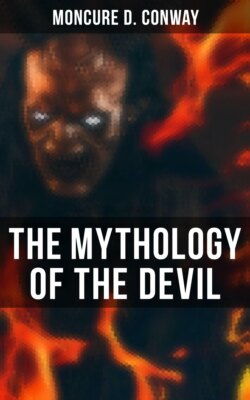The Mythology of the Devil

Реклама. ООО «ЛитРес», ИНН: 7719571260.
Оглавление
Moncure D. Conway. The Mythology of the Devil
The Mythology of the Devil
Table of Contents
Preface
Part I. Demonolatry
Chapter I. Dualism
Chapter II. The Genesis of Demons
Chapter III. Degradation
Chapter IV. The Abgott
Chapter V. Classification
Part II. The Demon
Chapter I. Hunger
Chapter II. Heat
Chapter III. Cold
Chapter IV. Elements
Chapter V. Animals
Chapter VI. Enemies
Chapter VII. Barrenness
Chapter VIII. Obstacles
Chapter IX. Illusion
Chapter X. Darkness
Chapter XI. Disease
Chapter XII. Death
Part III. The Dragon
Chapter I. Decline of Demons
Chapter II. Generalisation of Demons
Chapter III. The Serpent
Chapter IV. The Worm
Chapter V. Apophis
Chapter VI. The Serpent in India
Chapter VII. The Basilisk
Chapter VIII. The Dragon’s Eye
Chapter IX. The Combat
Chapter X. The Dragon-slayer
Chapter XI. The Dragon’s Breath
Chapter XII. Fate
Part IV. The Devil
Chapter I. Diabolism
Chapter II. The Second Best
Chapter III. Ahriman: The Divine Devil
Chapter IV. Viswámitra: The Theocratic Devil
Chapter V. Elohim and Jehovah
Chapter VI. The Consuming Fire
Chapter VII. Paradise and the Serpent
Chapter VIII. Eve
Chapter IX. Lilith
Chapter X. War in Heaven
Chapter XI. War on Earth
Chapter XII. Strife
Chapter XIII. Barbaric Aristocracy
Chapter XIV. Job and the Divider
Chapter XV. Satan
Chapter XVI. Religious Despotism
Chapter XVII. The Prince of this World
Chapter XVIII. Trial of the Great
Chapter XIX. The Man of Sin
Chapter XX. The Holy Ghost
Chapter XXI. Antichrist
Chapter XXII. The Pride of Life
Chapter XXIII. The Curse on Knowledge
Chapter XXIV. Witchcraft
Chapter XXV. Faust and Mephistopheles
Chapter XXVI. The Wild Huntsman
Chapter XXVII. Le Bon Diable
Chapter XXVIII. Animalism
Chapter XXIX. Thoughts and Interpretations
Отрывок из книги
Moncure D. Conway
Published by
.....
M. François Lenormant has written an extremely instructive chapter in comparison of the Accadian and the Finnish mythologies. He there shows that they are as one and the same tree, adapted to antagonistic climates.7 With similar triad, runes, charms, and even names in some cases, their regard for the fire worshipped by both varies in a way that seems at first glance somewhat anomalous. The Accadians in their fire-worship exhausted the resources of praise in ascription of glory and power to the flames; the Finns in their cold home celebrated the fire festival at the winter solstice, uttered invocations over the fire, and the mother of the family, with her domestic libation, said: ‘Always rise so high, O my flame, but burn not larger nor more ardent!’ This diminution of enthusiasm in the Northern fire-worshipper, as compared with the Southern, may only be the result of euphemism in the latter; or perhaps while the formidable character of the fire-god among the primitive Assyrians is indicated in the utter prostration before him characteristic of their litanies and invocations, in the case of the Finns the perpetual presence of the more potent cold led to the less excessive adoration. These ventured to recognise the faults of fire.
The true nature of this anomaly becomes visible when we consider that the great demon, dreaded by the two countries drawing their cult from a common source, represented the excess of the power most dreaded. The demon in each case was a wind; among the Finns the north wind, among the Accadians the south-west (the most fiery) wind. The Finnish demon was Hiisi, speeding on his pale horse through the air, with a terrible train of monster dogs, cats, furies, scattering pain, disease, and death.8 The Accadian demon, of which the bronze image is in the Louvre, is the body of a dog, erect on eagle’s feet, its arms pointed with lion’s paws; it has the tail of a scorpion and the head of a skeleton, half stripped of flesh, preserving the eyes, and mounted with the horns of a goat. It has four outspread wings. On the back of this ingeniously horrible image is an inscription in the Accadian language, apprising us that it is the demon of the south-west wind, made to be placed at the door or window, to avert its hostile action.
.....